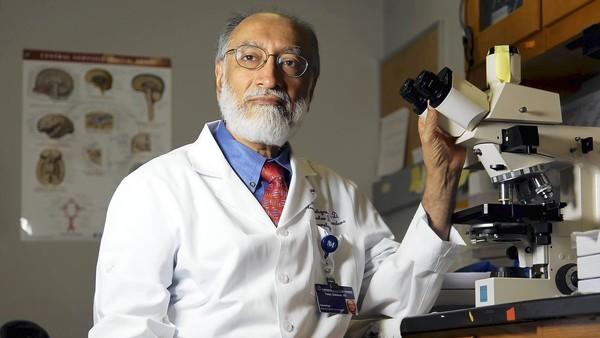
In the couple of hours it took an official from the ALS Association to return a reporter's call for comment, the group's ubiquitous "Ice Bucket Challenge" had brought in a few million more dollars.
Approaching $110 million, the viral fundraising campaign for the ailment also known as Lou Gehrig's Disease has put the ALS group into the top ranks for medical charity donations. Since the end of July, the money has been sloshing in at a rate of about $9 million a week. Last year, from July 29 to Aug. 26, the group raised just $2.6 million.
It's caught everyone off guard, none more so than the ALS Association folks. But they know this is likely a one-off phenomenon, and the group now faces the task of spending all that money wisely. Research, care and advocacy are the group's three main missions - but officials say they don't know yet exactly how they'll use the astonishing windfall.
"I think even if I or any PR person at either a non-profit or a for-profit company had all of the PR dollars in the world to invest, no one would have come up with this idea," said Carrie Munk, the association's spokeswoman. "We realize there are responsibilities that come with being good stewards of these dollars."
Part of what's surprising is that ALS - or amyotrophic lateral sclerosis - is one of those "orphan" diseases. It is a neurodegenerative disease that causes paralysis and death, and the association estimates that about 5,600 new cases are diagnosed in the U.S. each year.
This campaign hasn't exactly put the charity in the same neighborhood as giants like the American Cancer Society, the American Heart Association or Susan G. Komen for the Cure - which raised $889 million, $529 million and $310 million last year, respectively. But it's moving into the same ZIP code now.
"People who have been in this space for a long period of time feel like it's a dream come true," says Munk.
In case you've been under the proverbial rock, here are the basic rules: Someone issues a challenge - that you allow yourself to be doused with a bucket of ice and water, like winning coaches along the sidelines. Then, the challengee has 24 hours to make a $100 donation to the ALS Association or submit to the water torture.
In the last month, everyone from Microsoft co-founder Bill Gates to former President George W. Bush has been doused. The Internet and airwaves are awash in videos of people taking the challenge - even if they fully intend to write the check.
Jonah Berger, author of the book "Contagious: Why Things Catch On," says it's like a modern-day chain letter - except, in this case, everyone will know if you break the chain.
"It has a lot of the key ingredients that often make people want to share things," said Berger, a marketing professor at the University of Pennsylvania's Wharton School. "It gives people lots of social currency to be part of it. It makes you look good. It makes you look smart and in the know - you know what's going on. And it's always hard to back down from a challenge."
And now others are co-opting the bucket challenge for their own causes.
Actor Matt Damon, for instance, dumped toilet water over his head to call attention to his passion - safe drinking water. Actor Orlando Jones of the television series "Sleepy Hollow" showered himself with bullets in the wake of black teenager Michael Brown's shooting death by a white police officer in Ferguson, Mo.
"I'm challenging myself to listen without prejudice, to love without limits and to reverse the hate," he said. "So that's my challenge - to me. And, hopefully, you'll accept this challenge, too."
The Chronicle of Philanthropy says the ALS Association has, in this short period of time, raised more than many of the charities included on its Philanthropy 400 list.
"Right now, we're really focused on reaching out to and acknowledging and thanking the over 2 million donors that have come to the ALS Association," said Munk, the association spokeswoman. "And also working to put a process in place to make the best decisions to spend these dollars."
The American Institute of Philanthropy's CharityWatch gave the group a B+ rating for spending about 73 percent of its cash budget on programs. Analyst Stephanie Kalivas has no reason to believe that rating will need to be downgraded.
"We will definitely be keeping an eye out for them," she said. "Hopefully, they won't be wasteful with it."
Dr. Richard Bedlack, who runs the ALS clinic at the Duke Institute for Brain Sciences in Durham, N.C., knows how he would allocate the money. While the temptation might be to plow it all into the search for a cure, he says the biggest strides have been made in patient care and quality of life, and that would be his No. 1 priority.
"The chances of one of these research studies really finding meaningful disease-modifying therapy is very small," he says. "We're shooting in the dark. So, of course we've got to keep trying. But the bottom line is we've got to understand this disease better before we're going to be able to fix it in most people."

 Its close approach: the day of
Its close approach: the day of








 Researchers at Northwestern University say they have discovered a common cause behind the mysterious and deadly affliction of amyotrophic lateral sclerosis, or Lou Gehrig's disease, that could open the door to an effective treatment.
Researchers at Northwestern University say they have discovered a common cause behind the mysterious and deadly affliction of amyotrophic lateral sclerosis, or Lou Gehrig's disease, that could open the door to an effective treatment. 



